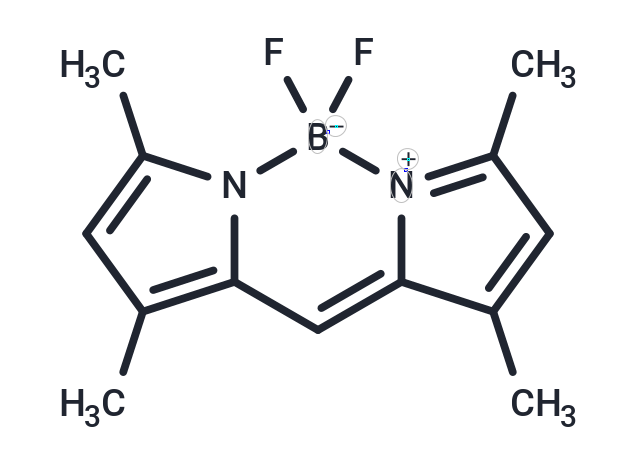Shopping Cart
Remove All Your shopping cart is currently empty
Your shopping cart is currently empty
BODIPY 505/515 is a lipophilic fluorescent probe that localises to intracellular liposomes and has been used to label lipid droplets.BODIPY 505/515 has been used in electron microscopy, epifluorescence microscopy, confocal microscopy, and flow cytometry applications for various algal species.

| Pack Size | Price | USA Warehouse | Global Warehouse | Quantity |
|---|---|---|---|---|
| 50 mg | $35 | In Stock | In Stock | |
| 100 mg | $50 | In Stock | In Stock | |
| 200 mg | $85 | - | In Stock | |
| 1 mL x 10 mM (in DMSO) | $55 | In Stock | In Stock |
| Description | BODIPY 505/515 is a lipophilic fluorescent probe that localises to intracellular liposomes and has been used to label lipid droplets.BODIPY 505/515 has been used in electron microscopy, epifluorescence microscopy, confocal microscopy, and flow cytometry applications for various algal species. |
| Cell Research | I. Lipid droplet labeling and visualization 1. Staining: Dissolve BODIPY 505/515 in an appropriate solvent (usually DMSO or ethanol) and then add it to the cell culture medium at a concentration of usually 1-10 μM. 2. Incubation: Incubate the cells at 37°C for 15-30 minutes to allow the dye to enter the lipid droplets. 3. Washing: After incubation, wash the cells with PBS or culture medium to remove excess dye. 4. Fluorescence imaging: Observe lipid droplets using a fluorescence microscope or confocal microscope. The fluorescence peak of BODIPY 505/515 is usually in the range of 505-515 nm. II. Lipid droplet quantification in flow cytometry 1. Cell staining: Add BODIPY 505/515 to the cell suspension and stain at the recommended concentration. 2. Incubation: After staining, incubate for an appropriate time. 3. Flow cytometry analysis: After washing, the fluorescence intensity of the cells is analyzed by flow cytometry to detect the number and size of lipid droplets. III. Lipid metabolism research 1. Cell treatment: Treat cells with compounds that may alter lipid metabolism, such as free fatty acids, drugs, or genetic modifications. 2. Fluorescence monitoring: After labeling the cells, the dynamic changes of lipid droplets are monitored in real time using fluorescence microscopy or flow cytometry. IV. Dynamic monitoring of lipids in algae 1. Algae staining: Similar to mammalian cells, algae are also stained for lipid droplets by BODIPY 505/515. 2. Imaging: Algal lipid droplets are observed using fluorescence microscopy to provide in-depth understanding of lipid storage dynamics. Notes 1. Concentration range: The typical working concentration of BODIPY 505/515 is 1-10 μM, and the specific concentration can be optimized according to cell type and experimental conditions. 2. Storage conditions: BODIPY 505/515 should be stored in a dark, cool place, preferably at -20°C to avoid photodegradation. 3. Fluorescence detection: BODIPY 505/515 emits green fluorescence under 490 nm excitation light, with the emission peak in the range of 505-515 nm, which is suitable for detection using conventional fluorescence microscopy and flow cytometry. |
| Molecular Weight | 248.08 |
| Formula | C13H15BF2N2 |
| Cas No. | 21658-70-8 |
| Smiles | CC1=CC(C)=[N+]2C1=Cc1c(C)cc(C)n1[B-]2(F)F |
| Relative Density. | no data available |
| Color | Green |
| Appearance | Solid |
| Storage | keep away from direct sunlight,store at low temperature | Powder: -20°C for 3 years | In solvent: -80°C for 1 year | Shipping with blue ice/Shipping at ambient temperature. | ||||||||||||||||||||||||||||||||||||||||
| Solubility Information | DMF: 25 mg/mL (100.77 mM), Sonication is recommended. DMSO: 15.31 mg/mL (61.71 mM), Sonication is recommended. | ||||||||||||||||||||||||||||||||||||||||
Solution Preparation Table | |||||||||||||||||||||||||||||||||||||||||
DMSO/DMF
DMF
| |||||||||||||||||||||||||||||||||||||||||
| Size | Quantity | Unit Price | Amount | Operation |
|---|

Copyright © 2015-2026 TargetMol Chemicals Inc. All Rights Reserved.